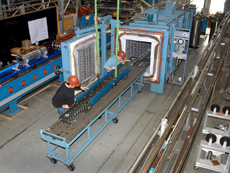Long Racetrack magnets
go the distance

One coil of the Long Racetrack magnet being moved into the reaction oven at BNL. Image courtesy Peter Wanderer, BNL
The LHC won't start up until next year, but physicists and engineers in Europe, Japan and the United States already are working toward collider upgrades. In a major milestone for the U.S. LHC Accelerator Research Program, the first Long Racetrack Shell magnet, a precursor of an upgraded superconducting quadrupole magnet, was successfully tested the week of July 23 at Brookhaven National Laboratory.
The U.S. group is working toward upgrades for the "inner triplet" quadrupole magnets that perform the final focusing of the particle beams prior to collision. Due to the magnets' proximity to the interaction points, the inner triplets are built to withstand high doses of radiation without failing. An upgraded, higher-luminosity LHC will mean a hotter environment for the magnets.
Because upgraded inner triplets will need to operate at a higher temperature and higher magnetic field, the U.S. team from BNL, Fermilab and Lawrence Berkeley National Laboratory is evaluating Niobium-Tin (Nb3Sn) technology for the magnet coils, rather than the well-established Niobium-Titanium used in current LHC magnets.
"Nb3Sn magnets would be an advantage because they can run at a higher temperature and higher magnetic field gradient, but the material is really hard to work with," explained BNL's Peter Wanderer, LARP's magnet systems leader. A European project, CARE/NED, is also investigating Nb3Sn conductors for use in upgraded LHC magnets.
The Long Racetrack Shell magnet, so called because of its shape, is the first accelerator-style Nb3Sn magnet to be fabricated significantly longer than one meter. The 3.6-meter long magnet approaches the length that will be needed for the LHC. BNL fabricated the coils for the LRS, LBNL designed and fabricated the support structure. Fermilab contributed through project management, conductor characterization, insulation development and the insulation of a practice coil.
The first of these magnets, LRS01, was tested the week of July 23 at BNL. "Training" of the magnet -- subjecting it to repeated quenches -- started above 80 percent of the magnet's estimated maximum current density of 10.6 kA. After five quenches the current reached 91 percent of the estimated maximum, corresponding to a coil peak field of 11 Tesla.
"The LRS01 magnet is providing key information for the fabrication of long niobium-tin coils and the optimization of shell-based support structures," said Paolo Ferracin from LBNL.
Fermilab's Giorgio Ambrosio, who coordinated the activities at the three labs, said "the next step for LARP is to build the Long Quadrupole, the first-ever 4-meter long Nb3Sn accelerator magnet model."
-- Katie Yurkewicz

The support structure of the Long Racetrack magnet. Image Courtesy Paolo Ferracin, LBNL
|